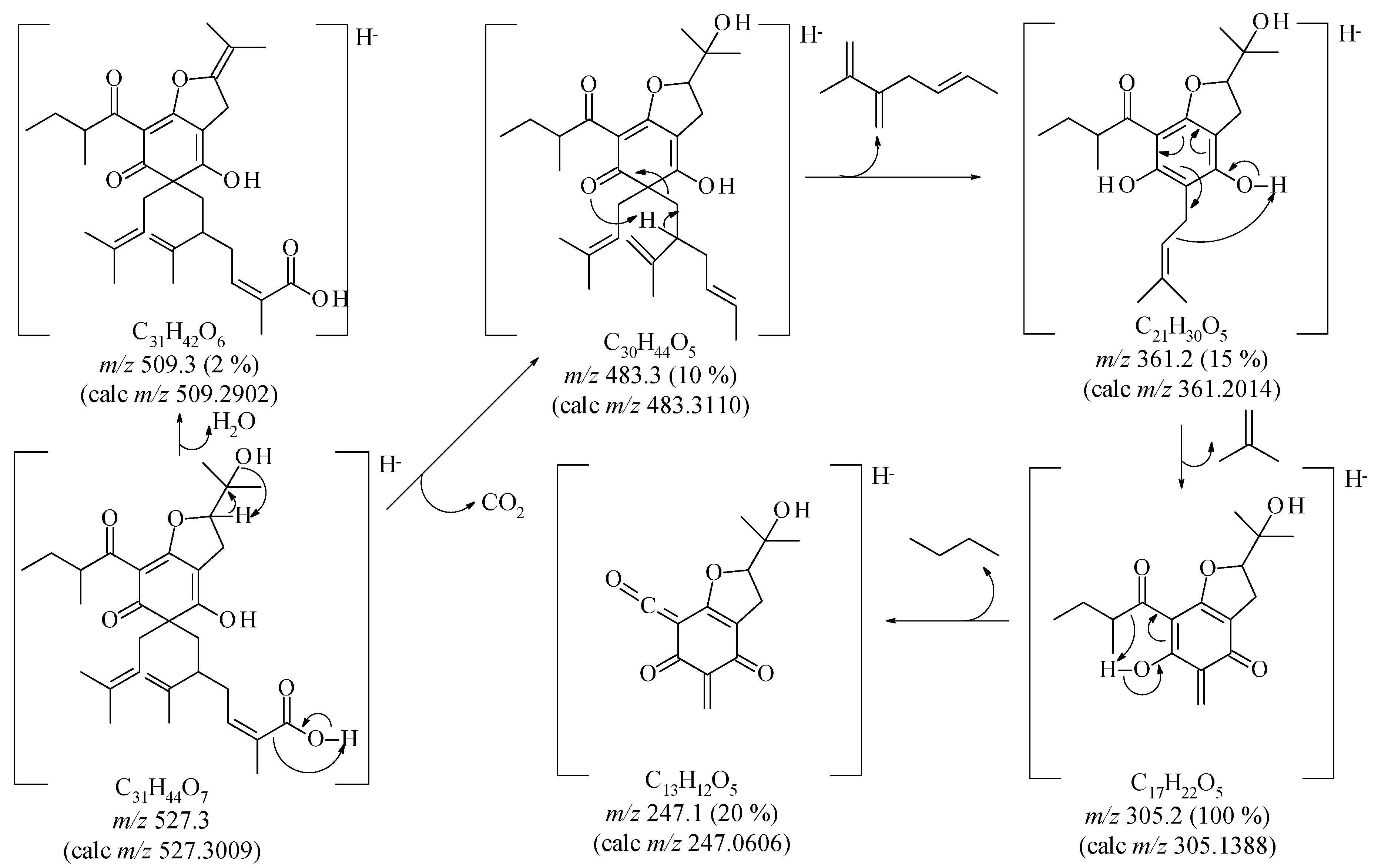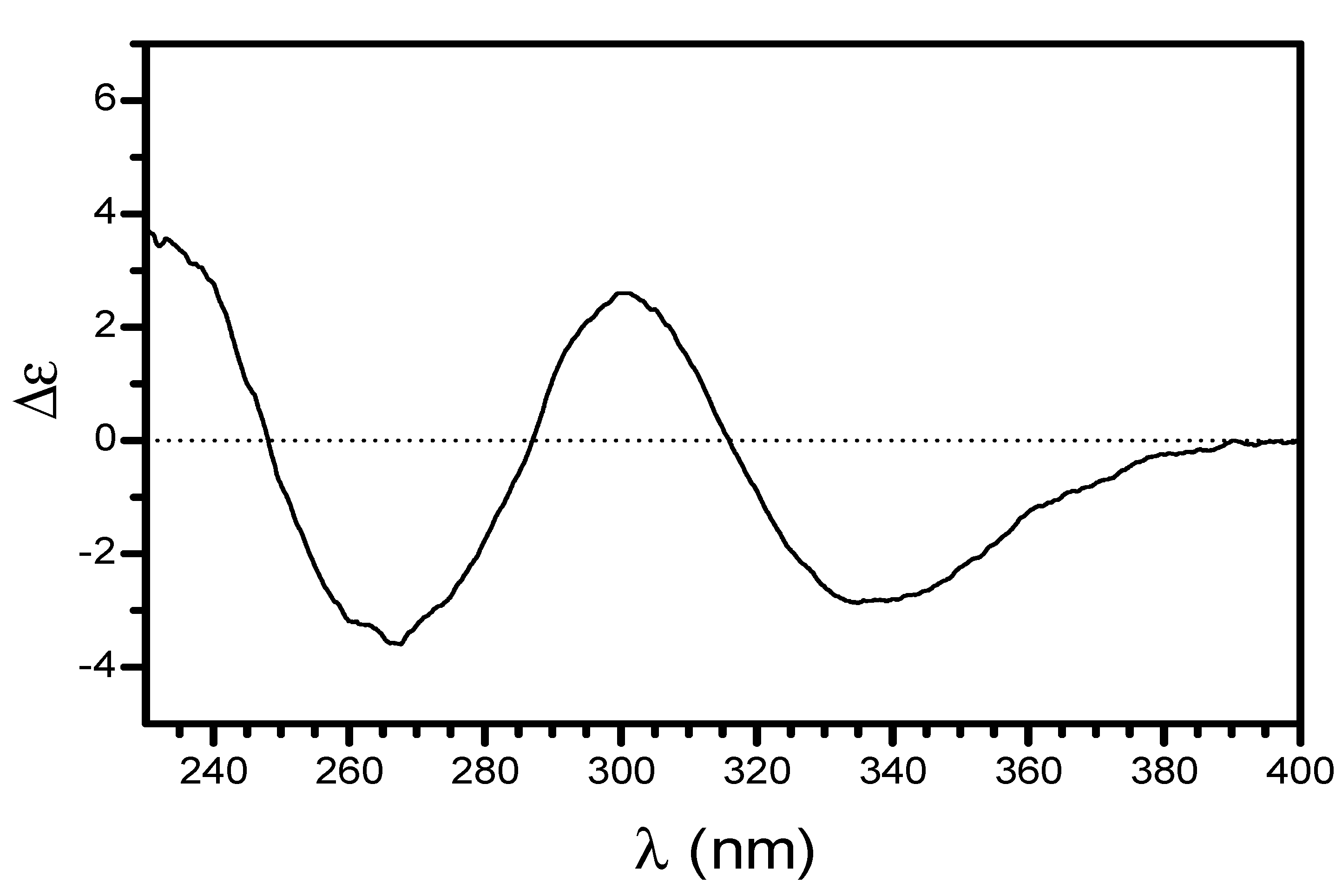New Polyprenylated Phloroglucinol and Other Compounds Isolated from the Fruits of Clusia nemorosa (Clusiaceae)
Abstract
:1. Introduction
2. Results and Discussion
| Position | δH | δC | HMBC(2,3JH-C) |
|---|---|---|---|
| 1 | - | 205.6 | - |
| 2 | - | 103.5 | - |
| 3 | - | 170.4 | - |
| 4 | - | 109.3 | - |
| 5 | - | 191.9 | - |
| 6 | - | 60.9 | - |
| 7 | 2.87–3.01 (m) | 26.6 | C-3; C-4; C-5; C-8; C-9 |
| 8 | 4.75–4.83 (m) | 92.4 | C-3; C-4 ;C-10; C-11 |
| 9 | - | 71.8 | - |
| 10 | 1.32 (s) | 24.8 | C-8; C-9; C-11 |
| 11 | 1.26 (s) | 24.6 | C-8; C-9; C-10 |
| 12 | 2.26 (br d, 10 Hz, H-12a); 2.08 (m, H-12b) a | 40.4 | C-1; C-5; C-6; C-13; C-14; C-17 |
| 13 | 2.14 (m) | 44.4 | C-6; C-14; C-15; C-17 |
| 14 | - | 145.7 | - |
| 15 | 4.51 (brs, H-15a); 4.52 (brs, H-15b) a | 114.1 | C-13; C-14; C-16 |
| 16 | 1.48 (s) | 17.8 | C-13; C-14; C-15 |
| 17 | 2.14 (m) | 33.3 | C-12; C-14; C-18; C-19 |
| 18 | 6.68 (brt, 6.6 Hz) | 142.5 | C-13; C-17; C-19; C-20; C-21 |
| 19 | - | 127.5 | - |
| 20 | - | 172.2 | - |
| 21 | 1.77 (s) | 12.0 | C-18; C-19; C-20 |
| 22 | 2.53 (brd, 7.3 Hz) | 42.2 | C-1; C-5; C-6; C-12; C-23; C-24 |
| 23 | 4.75–4.83 (m) | 116.8 | C-22; C-25; C-26 |
| 24 | - | 135.6 | - |
| 25 | 1.48 (s) | 17.6 | C-23; C-24;C-26 |
| 26 | 1.51 (s) | 25.7 | C-23; C-24; C-25 |
| 27 | - | 196.5 | - |
| 28 | 3.53 (sextet, 6.8 Hz) | 40.7 | C-2;C-27; C-29; C-30; C-31 |
| 29 | 1.45–1.50 (m, H-29a); 1.75 (m, 29b) a | 27.4 | C-27; C-28; C-30; C-31 |
| 30 | 0.93 (t, 7.3 Hz) | 11.9 | C-28; C-29 |
| 31 | 1.18 (d, 6.8 Hz) | 17.2 | C-27; C-28; C-29 |



3. Experimental Section
3.1. General Procedures
3.2. Plant Material
3.3. Extraction and Isolation
4. Conclusions
Supplementary Materials
Acknowledgments
Author Contributions
Conflicts of Interest
References
- Brittrich, V.; Amaral, M.C.E.; Machado, S.M.F.; Marsaioli, A.J. Floral resin of Tovomitopsis saldanhae (Guttiferae) and 7-epi-nemorosone: Structural revision. Z. Naturforsch. C 2003, 58c, 643–648. [Google Scholar]
- Ferreira, R.O.; Carvalho, M.G.; Silva, T.M.S. Ocorrência de biflavonoides em Clusiaceae: Aspectos químicos e farmacológicos. Quim. Nova 2012, 35, 2271–2277. [Google Scholar] [CrossRef]
- Ferreira, R.O.; Carvalho Junior, A.R.; Silva, T.M.G.; Castro, R.N.; Silva, T.M.S.; Carvalho, M.G. Distribution of metabolites in galled and non-galled leaves of Clusia lanceolata Cambess and antioxidant activity. Braz. J. Pharmacogn. 2014, 24, 617–625. [Google Scholar] [CrossRef]
- Oliveira, C.M.A.; Porto, A.M.; Bittrich, V.; Vencato, I.; Marsaioli, A.J. Floral resins of Clusia spp: Chemical composition and biological function. Tetrahedron Lett. 1996, 37, 6427–6430. [Google Scholar] [CrossRef]
- Oliveira, R.F.; Camara, C.A.; Agra, M.F.; Silva, T.M.S. Biflavonoids from the unripe fruits of Clusia paralicola and their antioxidant activity. Nat. Prod. Commun. 2012, 7, 1597–1600. [Google Scholar] [PubMed]
- Texeira, J.S.R.; Moreira, L.M.; Guedes, M.L.S.; Cruz, F.G. A new biphenyl from Clusia melchiorii and a new tocotrienol from Clusia obdeltifolia. J. Braz. Chem. Soc. 2006, 17, 812–815. [Google Scholar] [CrossRef]
- Cruz, F.G.; Texeira, J.S.R. Polyprenylated benzophenones with a tricyclo[4.3.1.13,8] undecane skeleton from Clusia obdeltifolia. J. Braz. Chem. Soc. 2004, 15, 504–508. [Google Scholar] [CrossRef]
- Oya, A.; Tanaka, N.; Kusama, T.; Kim, S.Y.; Hayashi, S.; Kojoma, M.; Hishida, A.; Kawahara, N.; Sakai, K.; Gonoi, T.; et al. Prenylated benzophenones from Triadenum japonicum. J. Nat. Prod. 2015, 78, 258–264. [Google Scholar] [CrossRef] [PubMed]
- Zhao, F.; Watanabe, Y.; Nozawa, H.; Daikonaka, A.; Konda, K.; Kitanaka, S. Prenylflavonoids and phloroglucinol derivatives from hops (Humulus lupulus). J. Nat. Prod. 2005, 68, 43–49. [Google Scholar] [CrossRef] [PubMed]
- Andrade, M.R.; Almeida, E.X.; Conserva, L.M. Alkyl chromone and other compounds from Clusia nemorosa. Phytochemistry 1998, 47, 1431–1433. [Google Scholar] [CrossRef]
- Farias, J.A.C.; Ferro, J.N.S.; Silva, J.P.; Agra, I.K.R.; Oliveira, F.M.; Candea, A.L.P.; Conte, F.P.; Ferraris, F.K.; Henriques, M.G.M.O.; Conserva, L.M.; et al. Modulation of inflammatory processes by leaves extract from Clusia nemorosa both in vitro and in vivo animal models. Inflammation 2012, 35, 764–771. [Google Scholar] [CrossRef] [PubMed]
- Cerrini, S.; Lambo, D.; delle Monache, F.; Pinherio, R.M. Nemorosonol, a derivative of tricyclo[4.3.1.03,7]decane-7-hydroxy-2,9-dione from Clusia nemorosa. Phytochemistry 1993, 32, 1023–1028. [Google Scholar] [CrossRef]
- Delle Monache, F.; delle Monache, G.; Gacs-Baitz, E. Two new polyisoprenylated ketones from Clusia nemorosa. Phytochemistry 1991, 30, 703–705. [Google Scholar] [CrossRef]
- Anjaneyulu, V.; Prasad, K.H.; Rao, G.S. Triterpenoids of the root-bark of Mangifera indica. Indian J. Pharm. Sci. 1982, 44, 85–87. [Google Scholar]
- Su-Yeon, K.; Dae-Young, L.; Kyeong-Hwa, S.; Young-Deok, R.; Gye-Won, K.; Dae-Sung, C.; Nam-In, B. Isolation and identification of lipids from the fruits of Acanthopanax sessiliflorus. J. Appl. Biol. Chem. 2012, 55, 103–107. [Google Scholar]
- Arora, M.; Kalia, A.N. Isolation and characterization of stigmasterol and β-sitosterol-D-glycoside from ethanolic extract of the stems of Salvadora pérsica Linn. Int. J. Pharm. Pharm. Sci. 2013, 5, 245–249. [Google Scholar]
- Markham, K.R. Techniques of Flavonoid Identification; Academic Press Inc.: London, UK, 1982; pp. 84–86. [Google Scholar]
- Hawranik, D.J.; Sorensen, J.L. The isolation of citric acid derivatives from Aspergillus Níger. FEMS Microbiol. Lett. 2010, 306, 122–126. [Google Scholar] [CrossRef] [PubMed]
- Holtzel, A.; Schlotterbeck, G.; Albert, K.; Bayer, E. Separation and characterisation of hop bitter acids by HPLC-1H NMR coupling. Chromatographia 1996, 2, 499–505. [Google Scholar] [CrossRef]
- Zhong, F.F.; Chen, Y.; Yang, G.Z. Chemical constituents from bark of Garcinia xantochymus and their 1,1-diphenyl-2-picrylhydrazyl (DPPH) radical-scavenging activities. Helv. Chim. Acta 2008, 91, 1695–1703. [Google Scholar] [CrossRef]
- Leminich, J.; Havelund, S.; Thastrup, O. Dihydrofurocoumarin glucoside from Angelica archangelica and Angelica silvestris. Phytochemistry 1983, 22, 553–555. [Google Scholar] [CrossRef]
- Sample Availability: Samples of the compounds are not available from the authors.
© 2015 by the authors. Licensee MDPI, Basel, Switzerland. This article is an open access article distributed under the terms and conditions of the Creative Commons Attribution license ( http://creativecommons.org/licenses/by/4.0/).
Share and Cite
Ferreira, R.O.; Da Silva, T.M.S.; De Carvalho, M.G. New Polyprenylated Phloroglucinol and Other Compounds Isolated from the Fruits of Clusia nemorosa (Clusiaceae). Molecules 2015, 20, 14326-14333. https://doi.org/10.3390/molecules200814326
Ferreira RO, Da Silva TMS, De Carvalho MG. New Polyprenylated Phloroglucinol and Other Compounds Isolated from the Fruits of Clusia nemorosa (Clusiaceae). Molecules. 2015; 20(8):14326-14333. https://doi.org/10.3390/molecules200814326
Chicago/Turabian StyleFerreira, Rafaela Oliveira, Tania Maria Sarmento Da Silva, and Mário Geraldo De Carvalho. 2015. "New Polyprenylated Phloroglucinol and Other Compounds Isolated from the Fruits of Clusia nemorosa (Clusiaceae)" Molecules 20, no. 8: 14326-14333. https://doi.org/10.3390/molecules200814326
APA StyleFerreira, R. O., Da Silva, T. M. S., & De Carvalho, M. G. (2015). New Polyprenylated Phloroglucinol and Other Compounds Isolated from the Fruits of Clusia nemorosa (Clusiaceae). Molecules, 20(8), 14326-14333. https://doi.org/10.3390/molecules200814326





